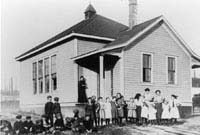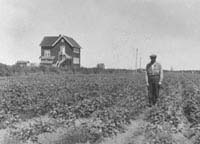The Early Years
1906 to 1939
 |
Steveston Elementary School in 1908. City of Richmond Archives Photograph 1978 1 23. Click to enlarge image. |
Prior to 1906, only four elementary schools existed, each located in its own separate school district: North Arm (Lulu School), Sea Island, Steveston (opened in 1897), and English. Three of these schools were named after their geographic locations while English was named after a local school board trustee and businessman, Marshall M. English. In 1906, these four districts were amalgamated into one, to form the Richmond School District. The hope was that there would be a co-ordinated effort in providing a basic educational program to all school-aged children regardless of where they lived on the islands. Up to this time, any student wishing to continue on to high school had to travel across the river either to Marpole in south Vancouver, Ladner in Delta, or New Westminster in order to complete a graduation diploma.
With the construction of two bridges connecting Marpole in Vancouver to both Sea and Lulu Islands in 1889 and the completion of the Fraser and Twigg Island Bridges in 1894 connecting Fraser Street in Vancouver to No. 5 Road in Richmond, the population of west and central Richmond increased significantly. As well, a bridge was constructed from New Westminster to Lulu Island on the eastern portion of the island allowing for even more settlement in Queensborough, a small enclave of New Westminster, and in East Richmond's Hamilton area.
As a result of this increased settlement from both Vancouver and New Westminster, the new school board faced the challenge of providing more educational spaces for students within Richmond itself. Three new schools, in addition to the previous four, became realities between 1906 and 1910. These included Bridgeport School at the corner of Bridgeport and Sexsmith Roads, Mitchell School at the corner of No. 5 Road and Cambie, and Trites School at the corner of No. 7 Road and Westminster Highway. The Japanese School in Steveston was also established, primarily supported and built by the Japanese community itself. The teacher, however, was subsidized by the School Board.
|
|
 |
Explore the links below to find out more about schools built during this period.

